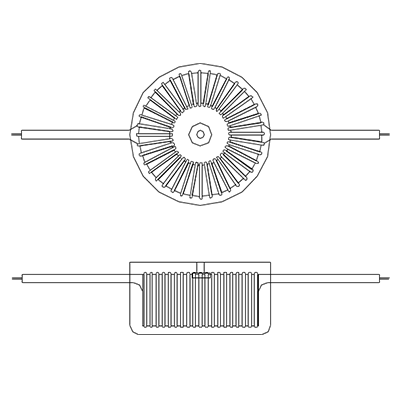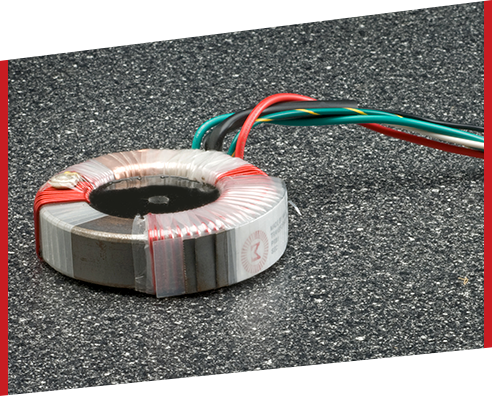A toroidal transformer is a special type of electrical transformer with a doughnut-like shape. It’s an ideal solution for low kVA (up to 15 kVA) rated devices and equipment used in medical, industrial, renewable energy and audio applications. Compared to a traditional laminated transformer, a toroidal transformer provides higher efficiency, a more compact size, and less audible vibrations and hum.
Advantages of a Toroidal Transformer vs. Standard Transformer
- Greater efficiency
- Lower stray losses (leakage flux)
- Lower audible vibration
- More compact size
- Easier mounting
Greater Efficiency
Standard toroidal transformers typically offer a 90 to 95 percent efficiency rating, while standard laminated transformers typically offer less than a 90 percent rating. If needed, Amgis even has the capabilities to design and build custom transformers with a 95 to 97 percent efficiency rating. The efficiency of a transformer is expressed as:
Efficiency = Pout / Pin
Pout is the output power delivered to the load, and Pin is the required power input to the transformer. The difference between Pin and Pout is considered the transformer’s power losses. Losses include, but aren’t limited to, core losses, winding (copper) losses, stray losses (leakage flux) and mechanical losses (vibrations). Generally, a bigger transformer, with the same power output rating, will have fewer losses and yield better efficiency ratings.
Efficiency ratings are also a good indication of the operating temperatures of the transformer. Typically, a lower efficiency rating will translate to a hotter operating transformer. The losses that a transformer experiences are removed in the form of heat. (This is the heat that you feel when an older laptop has been left on for several hours.) A toroidal transformer is more efficient and thus operates at a cooler temperature. This reduces the need for cooling fans or heat dissipation components, such as heat sinks.
Industry efficiency standards have evolved in recent years. Countries all over the world are requiring companies to design and build higher efficiency rated products to help cut down on material costs and to reduce resource consumption. Toroidal transformers serve as a method for achieving compliance with these new energy efficiency standards.
Low Stray Losses (Leakage Flux)
One of the most important differences between a toroidal transformer and a traditional laminated transformer is the absence of gaps. In a laminated transformer like an EI type (see figure below), three gaps exist where the “legs” of the Es connect with the Is. Leakage flux is released when the flux lines (or patterns) attempt to cross these gaps. The leakage flux contributes to the stray losses in the form of eddy currents (which is also expelled in the form of heat).
A toroidal core doesn’t have an air gap. The core is tightly wound on a mandrel, like a clock spring, from a continuous strip of grain-oriented electrical steel. The result is a stable, predictable toroidal core, free from discontinuities and holes.
The grain direction of the core type is also important. In a toroidal transformer, the grains all move in the same direction. After core excitation, the flux lines create a closed, or ideal, circuit. In an EI core, flux lines move in several different directions; this allows flux to escape from the corners and other unused areas.
Another contributing factor of stray losses is core utilization. In a toroidal transformer, windings completely cover the core. In a laminated transformer like an EI type, the windings only cover about 33 percent of the core. The concentration of the windings in that small region of the core leaves large portions of the flux path exposed. This abrupt transition from windings to bare laminates creates an opportunity for the flux to escape the confinement of the EI core and form linkage paths outside the transformer.
Low Audible Vibration
Audible vibration or hum in transformers is caused by vibration of the windings and core layers from the forces between the coil turns and core laminations. Clamps and welds can’t bind the whole structure, and laminations often loosen over time, causing increasing hum.
The toroidal transformer’s construction helps quiet this noise. Its core is tightly wound, spot welded, annealed and then coated with epoxy resin, if needed.
Brief audible hum may be noticeable immediately when powering it on because of the transformer’s inrush current, but it quickly stabilizes to a normal level (stabilization may occur up to two to three seconds after switch on).
In audio, or signal transmitting applications, unwarranted noise will affect sound quality, so a transformer with low audible vibration is ideal. For this reason, many sound system engineers decide to use a toroidal transformer instead of a traditional laminated transformer.
Compact Size
Compared to a traditional laminated core, using a toroidal core will yield a reduction in the size and weight of the transformer by 20 to 50 percent, without affecting the overall performance.
Because of the reduced size and weight, a toroidal transformer is the ideal choice for applications with strict size requirements. Furthermore, we can specifically design a transformer for a customer’s space.
Easier Mounting
Toroidal transformers are easy to mount. In most cases, all that is required to mount a toroidal transformer is one bolt. A traditional laminated transformer will require as many as four screws/bolts.
If additional support is needed or if the one bolt isn’t a viable option, we also offer the following mounting configurations: a vertically mounted transformer in between metal flanges, a transformer encapsulated inside a plastic or metal can, or a transformer mounted inside a custom plastic or metal enclosure.
Toroidal Transformer Mounting Hardware
Because of their compact size, our toroidal products are easy to mount, whether embedded into your equipment or bolted to a wall. We offer several mounting options, each dependent on toroid size and power rating.

Metal Disk with Insulating Pads
- Available for up to 1500VA
- Contents shipped unattached
- Rubber gaskets adhered to toroidal, optional
- Sizes proportional to VA size
- Provides a more efficient layer of protection against shock and vibration

Potted with Drilled Center Hole
- Available for all sizes
- Hole diameter specified by customer
- Concave potted bottom, optional
- Counter bore extension, optional
- Threaded insert, optional
- Custom potting options available

Potted in a Round or Square Enclosure
- Available for up to 1,000 VA
- Plastic or metal enclosures available
- Potted with thermoplastic material with threaded insert
- Thermally conductive epoxy material available, if specified
- Provides an excellent shell protectant against shock and vibration
- Variety of cup sizes and custom sizes available (tooling required)
Custom Toroidal Transformer Mounting
Our engineering staff can design a custom case, enclosure or bracket for your mounting requirements. Contact us to request custom toroidal transformer mounting hardware.





